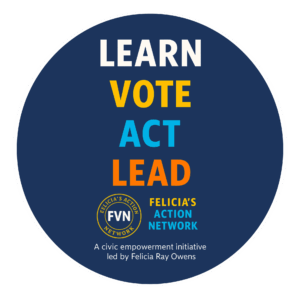
We’re hitting the road again…
April 16, 2025
Newsom Slams Trump with Lawsuit, Sends Love to Canada
April 16, 2025As the end date of the Trump administration’s foreign aid ‘stop-work’ order approaches, just how dependent were women and girls around the world on the U.S.? The Fuller Project dives into the data to find out.
This piece was published in partnership with The Fuller Project and Ms. magazine.
Published in partnership with The Fuller Project, a nonprofit newsroom dedicated to the coverage of women’s issues around the world. Sign up for The Fuller Project’s newsletter.
GOLINI, KENYA—Saumu Mwavugadi gazed from her veranda past mud-walled chicken coops and umbrella-like acacia trees to a vast horizon of hills. The heat was unrelenting on this March day, and Mwavugadi cradled her 2-week-old daughter in her arms.
She was wracked with despair.
“How will I get my baby vaccinated?” Mwavugadi worried aloud.
“Postnatal clinics feel like an impossible dream,” she said in Swahili. “The Vyongani Health Centre is 4 kilometers away [2.5 miles], across rough, rocky terrain. Making that journey on foot is not just difficult—it’s nearly impossible.”
Mwavugadi was not always pessimistic about accessing healthcare for her daughter and herself. During her recent pregnancy, a nurse and community-health volunteer had trekked up the narrow, winding paths that lead to her two-room house to provide the kind of prenatal care that helps ensure safe deliveries and healthy babies.
“I never realized that what I ate directly impacted my baby’s health,” Mwavugadi recalled. The support had made a difference, and she was looking forward to getting additional help after giving birth to Murfadh Mangale, her third child.
But because of decisions made 7,807 miles away, Mwavugadi is receiving no such help.

On the first day of his second stint in the Oval Office, President Donald Trump signed an executive order freezing all U.S. foreign assistance. Four days later, Secretary of State Marco Rubio halted foreign aid work already underway. Soon after that, Elon Musk and his so-called Department of Government Efficiency (DOGE) began to dismantle the U.S. Agency for International Development (USAID), and Rubio canceled 83 percent of its programs.
“Since Inauguration Day, I’d say the Trump administration has immediately gone to work in reckless, heartless and shameless ways that have attacked sexual and reproductive health and rights [and] LGBT rights,” said Caitlin Horrigan, senior director of global advocacy for the Planned Parenthood Federation of America. The rapid cutbacks, she said, caused “immediate harm, chaos and confusion around the world.”
One of the victims of the Trump administration’s actions is Stawisha Pwani, a $47-million project that began in 2021 and was set to run through June 2026, according to USAID data provided to the International Aid Transparency Initiative (IATI).
Stawisha Pwani was transformational to the mothers and children it served. It provided money for reproductive and family planning services, maternal and child healthcare, basic nutrition, and treatment for HIV/AIDS and sexually transmitted diseases to residents of four counties near the Indian Ocean in southeast Kenya. It also dispatched mobile healthcare workers to the homes of Mwavugadi and other women in hard-to-reach parts of Kwale County and its neighboring jurisdictions.
Kwale County’s HIV coordinator, Dr. Nana Mafumbo, said the project was “instrumental” in getting treatment to 12,000 of the estimated 15,000 county residents living with HIV. It also helped 1,000 pregnant women avoid transmitting the disease to their babies.

Now the work of Stawisha Pwani has come to a complete stop, and its future—and the health of the people it served—are at risk.
“With this support now gone, I don’t know how I will manage my postnatal visits,” Mwavugadi said. “I can only hope the county government steps in to sustain some of these services, as they have been a lifeline for pregnant and new mothers like me.”
U.S. Support for Women and Girls
There are millions of women like Mwavugadi around the world who, perhaps without even knowing it, have relied on the United States for vital, often life-saving services.
To get a sense of the global impact of the aid freeze, The Fuller Project analyzed data submitted by donor countries to the Organization for Economic Cooperation and Development (OECD), focusing on four key sectors that disproportionately affect women: reproductive health, including pre- and postnatal care, delivery, infertility treatment and post-abortion care; family planning, including the provision of contraceptives, counseling and education; addressing violence against women and girls; and supporting women’s rights organizations, movements and institutions. Reporters then combed through IATI data to identify specific programs, such as Stawisha Pwani on the Kenyan coast.
The data revealed that while the U.S. has long been the largest source of foreign assistance—contributing more than one-fifth of the world’s aid in 2023—its commitment varied by sector. The U.S. does not spend much globally to combat violence against women or to support groups aimed at advancing gender equality, the data showed.
But when it comes to family planning and reproductive healthcare, America has been unparalleled.

The U.S. contributed more than half (54 percent) of the foreign assistance provided by all countries for family planning and 45 percent of the aid for reproductive healthcare in 2023, the last year for which figures are available, according to a Fuller Project analysis.
Two years ago, 26 countries—19 of which are on the African continent—received more than half of their family planning aid from the United States. Nine countries, including Egypt, the Philippines and Uganda, depended on the U.S. for more than 90 percent of their family planning assistance. A dozen countries, meanwhile, received more than half of their reproductive healthcare aid from the U.S., the data shows.

Many of the aid recipients, like Afghanistan, are among the world’s poorest countries. But not all. Some, like Kenya and Egypt, are considered by the World Bank to be lower-middle-income nations, with per-capita incomes of up to $4,515 in 2023. Others, like Jordan and Guatemala, are upper-middle-income countries, with per-capita incomes of up to $14,005. Both received 99 percent of their family planning money from the U.S., though the sums are vastly different. By contrast, in 2023, the per-capita income in the U.S. was $82,769, higher than all but 10 other countries.

Jeopardizing Reproductive Health and HIV Treatment
The Guttmacher Institute, a research organization that promotes family planning and reproductive health services, estimates that every day, 130,390 women receive contraceptives from U.S.-funded programs. Already, hundreds of millions of dollars worth of contraceptives and other supplies are sitting in storage facilities around the world because the money to distribute them has dried up, said Elizabeth Sully, principal research scientist at Guttmacher.
“In just 90 days of suspended assistance, 11.7 million women and girls will be denied care, resulting in 4.2 million unintended pregnancies and 8,340 preventable maternal deaths,” Guttmacher and 33 other organizations that support reproductive rights wrote in a letter to Congress in early March. Congress had appropriated $607.5 million to such programs each of the past nine years.
If that money remains frozen past April 24, “we’re going to see an increase of women dying because of unsafe abortion, and women and newborns dying in childbirth as well,” echoes Sarah Shaw, associate director for advocacy at MSI Reproductive Choices, a London-based organization that works in 36 countries. The impact of Trump’s actions “is going to be catastrophic,” she said. “To be honest, we can’t even imagine the scale of this.”

This is not the first time family planning and reproductive health programs around the world have been curtailed because of American policies. Starting with Ronald Reagan in 1984, every Republican president has invoked the global gag rule (officially known as the Mexico City Policy), which prohibits foreign nonprofits that receive U.S. assistance from performing abortions; providing abortion counseling, education or referrals; or advocating for abortion as a method of family planning—even with their own money. (Every subsequent Democratic president has revoked this policy.)
The human costs global gag rule have been widely documented. In 2017, when Trump expanded the policy to encompass all healthcare aid, rather than family planning assistance alone, 108,000 women and children died as a result and 360,000 people contracted HIV/AIDS, according to a journal of the National Academy of Sciences.
Eight years later, the United Nations agency that coordinates the global response to HIV/AIDS is warning of a steep rise in infection rates and fatalities. The Trump administration has frozen funding to the President’s Emergency Plan for AIDS Relief, or PEPFAR, though it did grant the program a limited waiver to provide “life-saving” care.
“We will see a real surge in this disease, and we will see people dying the way we saw them [dying] in the ’90s and in 2000s,” Winnie Byanyima, the executive director of UNAIDS, told journalists in Geneva in late March. “And for Africa, the closing down, all of a sudden, of drop-in centers for girls and young women will be disastrous because more than 60 percent of new infections on the continent are amongst girls and young women.”
A 30-Year Rollback in Healthcare Access
No one can fill the breach left by the United States. Few seem to be trying.
On the contrary, some European countries are significantly reducing their aid budgets.
In November 2024, the new far-right government in the Netherlands, which was Europe’s second-largest donor of sexual and reproductive healthcare funding between 2012 and 2022, announced plans to reduce its development budget by 1 billion euros ($1.07 billion) over five years. While that represents a significant reduction from the previous 1.4 billion euros ($1.5 billion) budget, it’s unclear how much of it is earmarked for family planning or reproductive healthcare.
The United Kingdom, which, according to OECD data, was the second-largest donor in family planning assistance in 2022, announced in February that it, too, was cutting foreign aid.
“We’re seeing almost a 20- to 30-year rollback in access to health[care],” said Neil Datta, executive director of the European Parliamentary Forum for Sexual and Reproductive Rights. European countries, he explains, are “increasing defense spending because of the unreliability of the Trump administration’s commitment to NATO and [Trump’s] apparent pivot towards the Russian Federation and what looks like a very shaky commitment to Ukraine.”
Normally, countries might look to the United Nations Population Fund to help finance programs on sexual and reproductive health. However, the Trump administration’s stop-work order has halted much of the UNFPA’s work as well.
Heading into 2025, the U.S. had granted the UNFPA $377 million to operate 48 programs around the world; 41 of them, totaling $288 million, have been terminated, the UNFPA reported. Of those, two of the largest 10 grants, totaling nearly $78 million, were in Afghanistan, according to the UNFPA.
Altogether, the agency supports 552 health clinics that treat women in Afghanistan, said Sarah Craven, director of UNFPA’s Washington, D.C., office. “They’ll be closed by the end of the year,” she added. “So that’s just going to further strain fragile health systems in a country that has the eighth-highest maternal mortality rate in the world.”
Many women in Afghanistan have already lost their only access to reproductive services and other healthcare, said Seema Ghani, chair of the Afghan Family Guidance Association, a nongovernmental organization that provides reproductive care to women at clinics and mobile health units in remote areas as well as in one brand-new hospital in Kabul.
“We’re stopping the standard, ordinary reproductive health to women,” Ghani said. “And we’re talking about women [who] did not have access to any health centers in their life before.”
Back on the Kenyan coast, local health officials are trying to mitigate the impacts of the aid freeze as best they can.
Mafumbo, the Kwale County HIV coordinator, said staff cuts that eliminated 72 reproductive healthcare jobs are “forcing [remaining employees] to work twice as hard to fill the gaps.” Leaders in neighboring counties say they are meeting with national government and treasury officials to try to reallocate money from elsewhere in their budgets to salvage some aspects of the Stawisha Pwani program.
The fact is international funding for reproductive health and family planning had been declining even before the U.S. aid freeze. Between 2019 and 2023, funding for family planning fell by 21 percent, while contributions to the reproductive health sector rose by a meager 0.6 percent, the OECD data shows.
Neither sector accounted for more than 1 percent of total global aid.
Great Job Jodi Enda, The Fuller Project & the Team @ Ms. Magazine Source link for sharing this story.








